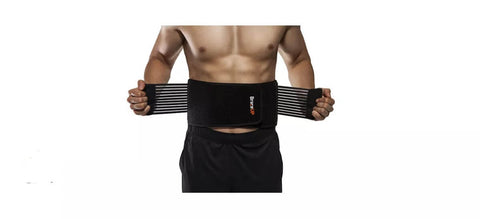How to use a back brace?
The Right Fit

When it comes to using a back brace, getting the right fit is crucial. A poorly fitting brace can cause discomfort, and irritation, and may not provide the necessary support. That's why it's important to get assistance when selecting a brace. Consult with a healthcare professional or an experienced sales representative to ensure that you choose the right size and style of brace for your needs.
Before purchasing a brace, measure your waist to determine your size. The brace should fit snugly around your waist and provide compression to support your lower back. Make sure that the brace doesn't ride up or down and remains in place while you move.
Once you have your brace, adjust the straps or laces to ensure a comfortable and secure fit. Don't hesitate to ask for assistance if you're having trouble getting the right fit. With a properly fitting back brace, you'll be able to move comfortably and enjoy the full benefits of the support it provides.
How to Use a Back Brace

If you have been prescribed a back brace, it is important to know how to properly use it to maximize its benefits. Putting on a back brace may seem daunting at first, especially if you do not have anyone to assist you. However, with a few simple techniques, you can put the brace on yourself without further straining your back.
First, make sure that the brace fits properly. A back brace that is too tight can restrict your movements and cause discomfort, while a brace that is too loose will not provide the support that you need. It is important to follow the instructions that come with the brace to ensure that you get the right fit.
If you do not have anyone to help you put on the brace, you can use a chair to assist you. Place the brace on a chair with the wings open and sit down with the wings on either side of your body. Then, stand up while holding the wings. Make sure that the brace is centred on your back and adjust the straps as needed to get the right fit.
When wearing the brace, it is important to maintain good posture and avoid slouching. This will help to prevent further strain on your back and ensure that the brace is providing the support that you need. If you experience any discomfort or pain while wearing the brace, remove it immediately and consult with your healthcare provider.
When to Wear a Back Brace

Wearing a back brace can be very beneficial in providing support and stability to the back. However, it is important to wear the brace only when necessary and for the appropriate length of time. Here are some instances when a back brace might be helpful:
- After a Back Injury: If you have suffered a back injury, wearing a back brace can help support the affected area and prevent further injury. However, it is important to consult with a medical professional to determine the appropriate type of brace and length of time to wear it.
- During Heavy Lifting: If you have a job or engage in activities that involve heavy lifting, wearing a back brace can help prevent strains or injuries to your back. Make sure to wear the brace snugly and follow proper lifting techniques.
- Post-Surgery: After back surgery, wearing a back brace can help provide support and stabilize the area as it heals. Follow your surgeon's recommendations for when to wear the brace and for how long.
- Chronic Pain: If you suffer from chronic back pain, a back brace can help alleviate some of the discomforts by providing support to the affected area. However, it is important to address the underlying cause of the pain with a medical professional and not rely solely on a back brace.
Remember, wearing a back brace should not replace proper exercise, stretching, and other forms of back care. Use it as a tool to help support your back in certain situations, and always consult with a medical professional for guidance.
